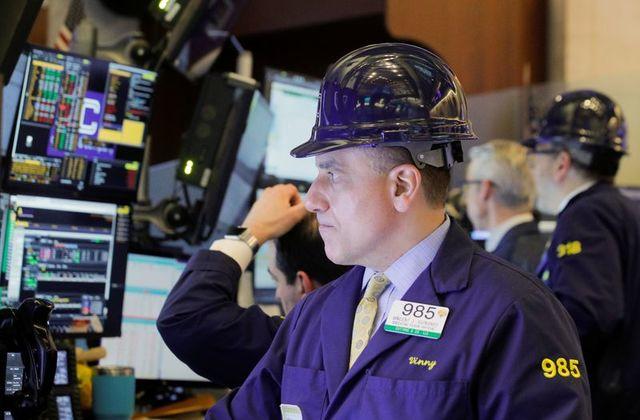“Hard Hats At The Ready…”
Tyler Durden
Mon, 06/15/2020 – 08:22
Authored by Bill Blain via MorningPorridge.com,
“I’m not ready for Monday – I’m going back to sleep..” (She-who-is-Mrs-Blain, this morning.)
I understand the supply of high-quality recreational pharmaceuticals is fairly limited at present, so if anyone can send me a quarter ounce of whatever Morgan Stanley are smoking I would be profoundly grateful. Apparently the global economy is in a new expansion cycle, and we will surpass pre-coronavirus GDP before the end of this year in a V-Shaped Recovery, say my American former employers (many years ago..) Excellent!
Sadly, no one seems to be sharing Morgan Stanley’s particular bullish insight with the market – which is setting up this morning for a “bit of a tanking” and a third consecutive down day. Markets are going to remain… fraxious… for the next few days. Volatile, risk off and expect to see the bad news mount…
Hard Hats at the ready…
There are two big forces dominating market levels at present:
1) Short-term reactions: the daily news blurb primes the market to make a binary flip between Risk On/Risk Off days – RoRo as some are calling it. The buttons being pressed include the daily threats on new virus hotspots from Brazil, Beijing and Texas, second waves, US authorities warning they will keep borders closed, negative nellies on the TV, and general exhaustion with the news flow. For instance, who cares if Larry Kudlow said Jay Powel was too ”morose”, although he did say US unemployment could remain above 8%.
2) The Global Central Bank Put – how can markets head lower when the authorities simply can’t afford for it happen? It’s a free option, knowing they will intervene with another flood of liquidity and bailouts – if they can get their act together.
These two forces are essentially balancing each other. The danger is it turns chaotic. It feels like it might happen….
The short-term reactive news, and central bank promises, don’t address the real long-term threat issues to the global economy, which include:
-
Growing Civil Unrest and rising dissatisfaction with governments.
-
The rising number of bankruptcies.
-
Companies, like BP this morning, raising provisions and scaling back investment.
-
Growing geopolitical tension.
-
Politics – the outlook for the US November elections has swung away from Trump – causing conniptions across C-Suites!
-
Disincentives to save as returns crash to zero.
-
Rising unemployment, growing corporate insolvency threats and a rising sense of wobble.
The market’s extreme detachment from the dismal underlying economic reality has become a major force in itself. The wider it is, the greater the prospect of a major shock/correction if it’s seen to be reversing.
Good luck to the UK this morning as shops reopen –I expect “shopping with confidence” will prove underwhelming, and yet another gaff by our flolloping and accident-prone premier, Boris Johnson.
And then there is the Coronavirus itself. Lockdowns are breaking down. Everyone wants normality. Whatever we think about the apparently reduced threat – it’s not going to magically vanish. Get used to it. It remains a very real threat from top to bottom of the global economy:
-
It’s going to change the way people shop, work and travel.
-
It’s going to change government policy – especially in terms of intervention in markets and commerce.
-
It’s going to change corporate behaviours.
I would guess that by this stage we all know someone who has spent considerable time in hospital with Covid-19. They are now in recovery, but have profound and ongoing medical issues. It’s increasingly clear we still don’t know enough about the virus. Over the weekend I was reading about how it seems to be more a vascular viral infection than an evolved flu. If you get it bad it’s taking out organs, triggering strokes and heart-attacks through blood clots. It requires new treatments.
More than ever, I’m convinced Health and Pharma are areas for investment. The virus could prove a dominant economic theme through this decade. I also fear the vaccine could well be delayed if we discover we’re addressing the wrong symptoms rather than the cause. (Virus hopes are another new-factor fuelling delusional V-Shaped recovery hopes.)
Then there is the bond market. In bonds there is truth. Or at least there used to be. Today bond yields have been depressed to such artificially low rates as to be meaningless. But the key attribute of bond yields is relative value – they set the return rate across financial assets. Ultra-low rates force investors to take greater risk in return for decreasing yields. Which is now illustrated by the amount of money chasing stocks – which are making lower profits and going to pay lower dividends.
When rates are this low and returns are crashing… well… I’m just not very happy to be thinking my pension pot is now going to be paying me pennies, but I will still be taxed to infinity to pay gold-plated final salary pensions to Civil Servants and such. This picture is not getting any better…
The big debates in bonds boil down to sovereign credit. The ability of governments to freely bailout insolvent companies, create jobs through fiscal infrastructure spending and pay rising social security costs is a function of their ability to raise money from the market. Traditionally that’s a function of the credibility of the country – not a problem for the dollar, but a massive problem for Italy.
As countries lose credibility and their ratings and currencies slide – can they bear the costs of the virus? If you believe in the magic of Modern Monetary Theory – that countries can effectively digitalise unlimited money with zero side effects… Phew.. we should be alright. If not.. then back to the old rules; the conventional Reinhart/Rogoff wisdom says sell any country with a debt/gdp ratio higher than 90%.
Am I too late to move to New Zealand?
via ZeroHedge News https://ift.tt/2AsX6QP Tyler Durden
